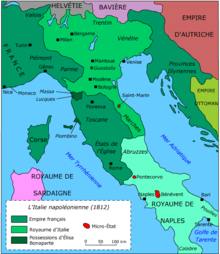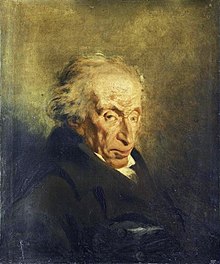Italian unification
![]()
The title of this article is ambiguous. For the opera by Lorenzo Ferrero, see Risorgimento! (opera).
The Risorgimento (Italian![]() "resurgence") refers to an epoch in Italian history between 1815 and 1870. It is also understood to include ideologically very heterogeneous political and social movements which, at the Congress of Vienna of 1814/15, strove to unite the then autonomous principalities and regions of the Apennine Peninsula in an independent national state of Italy. After several revolutionary uprisings and the Italian Wars of Independence, this state was enforced with the proclamation of the Kingdom of Italy as a constitutional monarchy in 1861 and was completed for the time being in 1870 with the military capture of the remaining Papal States (essentially the region of Lazio) and its capital Rome by Italian troops.
"resurgence") refers to an epoch in Italian history between 1815 and 1870. It is also understood to include ideologically very heterogeneous political and social movements which, at the Congress of Vienna of 1814/15, strove to unite the then autonomous principalities and regions of the Apennine Peninsula in an independent national state of Italy. After several revolutionary uprisings and the Italian Wars of Independence, this state was enforced with the proclamation of the Kingdom of Italy as a constitutional monarchy in 1861 and was completed for the time being in 1870 with the military capture of the remaining Papal States (essentially the region of Lazio) and its capital Rome by Italian troops.

Habsburg states, Bourbon states, red years = annexation to Sardinia-Piedmont or Italy.
Historical classification, interest groups
In research, the era of the Risorgimento is also defined more broadly by some historians, such as Werner Daum. They place the beginning of the Italian unification movement as early as the republican-Jacobin uprisings inspired by the French Revolution of 1789 and the short-term founding of republics after Napoleon Bonaparte's first military successes in some Italian regions from 1796 onwards (cf. Daughter Republic). In correspondingly broader historical interpretations, the Risorgimento is not considered complete until 1915 - with Italy's entry into the FirstWorld War - or 1919, after the end of the war and the incorporation of the so-called Terre irredente (Italian for "unredeemed territories") in northern Italy, which until then still belonged to Austria-Hungary.
In terms of the pan-European context, the Risorgimento was part of the nation-state independence and unity movements, originally oriented towards classical liberalism, which were directed in large parts of Europe from 1815 onwards against the repressive restoration policies of the Holy Alliance states. These movements were initially - in the first half of the 19th century - inspired by the ideals of the French Revolution, especially the civil liberties formulated in the Declaration of the Rights of Man and of the Citizen in 1789 and disseminated throughout Europe by Napoléon Bonaparte with the Code Civil.
In the socio-economic sphere, the Risorgimento as an epochal concept went hand in hand with the fundamental social and economic upheavals of the Industrial Revolution, which had begun in England in the mid-18th century and spread to continental Europe in the course of the 19th century. Italy, like most of the Mediterranean, continued to be dominated by an agrarian economy for a long time. Around the 1860s, the country was relatively late to be gripped by any significant industrialization - especially in northern Italy - whereas the south remained agricultural and permeated by feudalism-like structures for a long time. Nevertheless, the Italian states were also affected by the economic innovations in Europe, especially with regard to foreign trade, financial policy and the pricing of exported craft and above all agricultural products. This applies with the restriction that southern Italian regions in particular were primarily self-sufficient or domestically oriented in their economic activities and were thus initially less dependent on exports or imports from the international market.
The Risorgimento was supported by interest groups with different ideological orientations. The goals ranged from the establishment of a constitutional Italian monarchy (essentially supported by the faction of moderati = moderate liberals or so-called liberal conservatives) to the creation of a democratic republic (primarily represented by the factions of democratici = democrats, ranging from the radical liberals to the early socialists). Despite their sometimes fierce political controversy, all these currents had one idea in common: the ideology of a then progressive, more or less strongly developed nationalism, which had been gaining strength in most European states since the French Revolution and was essentially supported by the initially liberal-revolutionary bourgeoisie.
Several uprisings were directed primarily against the domination of the Bourbons in the Kingdom of the Two Sicilies and the Habsburg Austrians in northern and central Italy. These uprisings extended to revolutions and wars, whereupon Italian unity was ultimately imposed "from above" - as a constitutional monarchy with hereditary royal throne of the House of Savoy - in 1861 under the leadership of Sardinia-Piemont. The provisional conclusion of the territorial formation of the state came in 1870 with the capture by Italian troops of Rome and the Papal States, which after 1860 were limited to Lazio.
"However, the Risorgimento has never been able to win an ideological mass base. The idea of the necessity [...] of the nation-state remains limited to the educated and propertied classes [...]. The overwhelming majority of Italians, especially in the countryside and most markedly in the South, are uncomprehending to hostile to [these ideas]."
End of 18th century until 1815
Already at the end of the 18th century there had been efforts to "restore" Italian unity, which admittedly had not existed since the decline of the Ostrogothic Empire in the 6th century. The states and principalities of the Apennine Peninsula had been a political pawn of the great European powers since at least the 16th century with the beginning of the Italian Wars and the decline of the powerful Italian city-states at the end of the Renaissance.
During the years of the French Revolution (1789 to 1799), under the impression of the first French Republic proclaimed in 1792, Italian Jacobins had come together in patriotic groups. In Turin, Naples, Palermo and other regions, these groups were the first to attempt to implement the demand for an indivisible Italian republic through - ultimately unsuccessful - uprisings.
Starting in particular from northern Italy, it was Filippo Buonarroti, influenced by early socialist ideas, who early on sought Italian unification on a social revolutionary basis. Originally from Pisa in Tuscany, he had espoused the ideas of the French Revolution from the outset, but had initially been forced to withdraw from Italy and had himself taken part in the revolutionary upheavals in France. As revolutionary commissioner for the region of Oneglia, occupied in Piedmont, Buonarroti attempted in 1794/95 to transfer the revolutionary changes in France to Italian conditions. Due to intrigues against him, he was recalled to Paris and sentenced to imprisonment. In prison he met the French revolutionary Gracchus Babeuf and joined his conspiracy of equals (Conjuration des Égaux) a few months after his pardon.
In March 1796 Buonarroti again went to northern Italy, where he tried through conspiratorial activities to win over important figures in the French army in Italy, among them the new commander-in-chief Napoleon Bonaparte, to an Italian unification. Buonarroti's followers succeeded in establishing a revolutionary Jacobin rule in the Piedmontese town of Alba for a few weeks. They also attempted to mobilize other revolutionary forces in Piedmont and Lombardy.
As a representative of the Conspiracy of Equals, Buonarroti developed plans to change the agrarian conditions in France and Italy. Thus he advocated the abolition of private ownership of land. With his agrarian policy Buonarroti wanted to bind the masses of landless peasants to the "equals". He did not succeed in implementing his far-reaching social-revolutionary plans because both the mass of small farmers and the Italian Jacobins refused to support him on crucial points. In the end, all Jacobin attempts to transfer the radical changes of the first years of the revolution to Italy failed. Instead, Napoléon Bonaparte, as military commander-in-chief under the rule of the Directory, which had taken power in France after the fall of Robespierre and the constitutional amendment of 1795 (Directory Constitution), first prevailed with military force and a more moderate policy of bourgeois reforms.
In the course of the coalition wars between the European monarchies and revolutionary France from 1792/93 onwards, the world of states of old Italy collapsed. From 1801, after Napoleon Bonaparte's Italian campaigns, which were strategically directed mainly against Austria, the entire Apennine peninsula was under French domination. Even before the coronation of Napoleon I as emperor in 1804 - and thus the founding of the first French empire - fundamental changes took place in the Italian states.
Between 1796 and 1802, after Napoléon's first exterritorial successes (while still a general of the late revolutionary French Republic under the rule of the Directory - until 1799), various republics were founded, each as vassal states or daughter republics, as it were, of the French First Republic. In northern Italy, these were the Cispadanic and Transpadanic Republics of 1796 (which were merged in 1797 to form the Cisalpine Republic with its capital in Milan), the Ligurian Republic in the province around Genoa, and the Piedmontese Republic in Turin/Piedmont. In the territory of the dissolved Papal States, the Roman Republic and in Naples the Parthenopean Republic were created.
Furthermore, Napoléon - first consul of France after his coup d'état of 1799 - founded the Kingdom of Etruria in Tuscany (1801-1807). After Napoléon's proclamation as emperor of the French in December 1804, a kingdom of Italy was proclaimed under the Bonaparte dynasty, and a kingdom of Naples in 1806, partly by transforming the petty republics previously established. Until 1809, the rest of Italy was annexed by France.
The hallmarks of Napoleonic domination in Italy were a powerful centralist bureaucracy, the realization of civil rights through the Code Napoléon, the abolition of the feudal order, and an internal structural change in the Italian states. With all the growing dissatisfaction of many Italians with despotic subjugation in favor of the interests of France, and with all the disappointment of revolutionary hopes in the liberal and democratic-minded bourgeoisie, a new civic consciousness and the idea of national unification in a free Italy, which was no longer to be merely a geographical concept, emerged. This development of a sense of a supra-regional national identity, which took place primarily in the middle classes, was the essential precondition for the emergence of the Risorgimento after the military termination of Napoleonic hegemony in the politically fragmented regions of Italy.

Division of Italy under Napoleonic Hegemony 1812 (French language map)
.png)
Napoléon Bonaparte as first consul of France after his first military successes in Italy, c. 1799

Filippo Buonarroti (1761-1837), mastermind of Italian unification on a social revolutionary basis
Questions and Answers
Q: What is Italian unification?
A: Italian unification, also known as the Risorgimento, is a movement that united the Italian states in the 19th century.
Q: When did the movement begin?
A: The movement began in 1815 with the Congress of Vienna.
Q: Who were some of the key figures involved in unifying Italy?
A: Count Cavour, who was Prime Minister of Piedmont, and Giuseppe Garibaldi, an Italian national hero who unified southern Italy were both important figures involved in unifying Italy.
Q: How did Rome become the capital of Italy?
A: Rome became the capital of Italy through the efforts of Count Cavour and Giuseppe Garibaldi.
Q: Who was made King when Italy was unified?
A: King Victor Emmanuel II was made King when Italy was unified.
Q: What year did Italian unification end?
A: Italian unification ended in 1871.
Q: What does "Risorgimento" mean?
A: Risorgimento means "the Resurgence".
Search within the encyclopedia